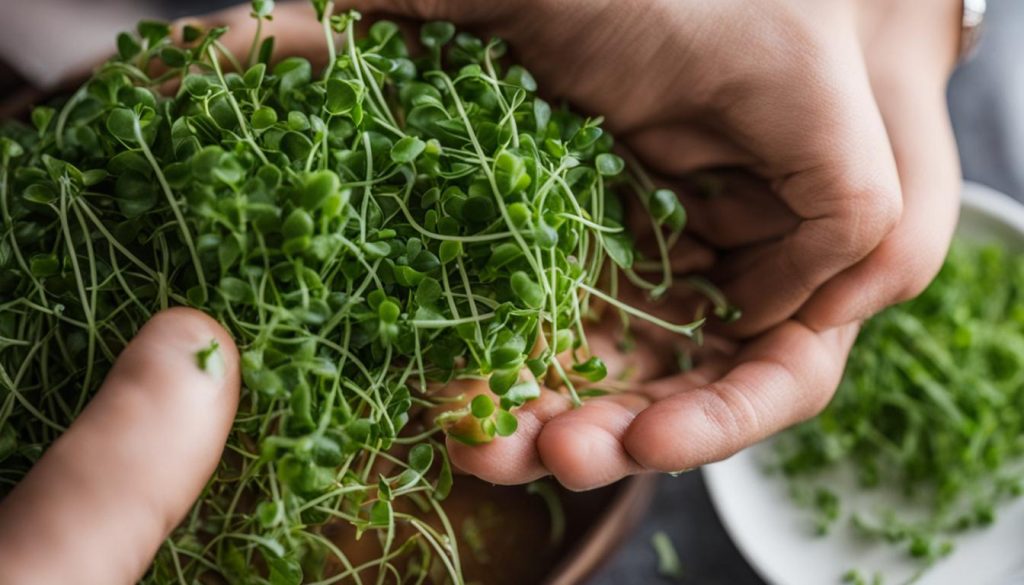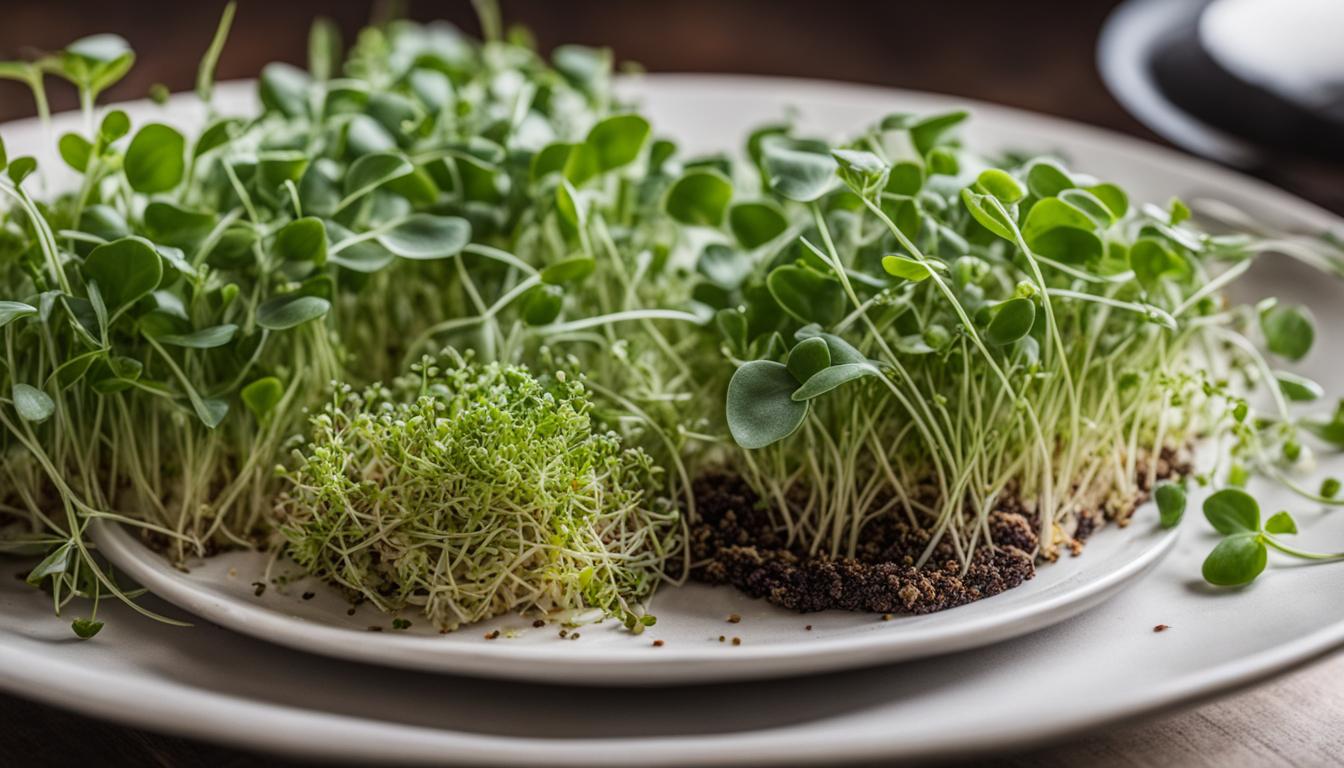Microgreens have surged in popularity, lauded for their nutritional potency and ease of cultivation. Yet, just like any agricultural endeavor, they come with their own set of considerations that could be seen as disadvantages. Smart gardeners and consumers alike should be aware of the potential drawbacks of microgreens that go beyond their vibrant hues and bursts of flavor. Whether it’s the financial outlay for indoor planting systems or the learning curve associated with this style of horticulture, uncovering the negative aspects of microgreens is essential for a realistic expectation of their role in our diets and gardens.
Though the process can be straightforward, the transition from conventional gardening to the tailored needs of indoor microgreens can pose unexpected challenges. This can include the frustration of initial failures, a common part of the learning experience. Moreover, potential risks such as the use of pesticides and the threat of water contamination may give would-be growers and eaters pause, raising questions about the purity and safety of these trendy, tiny greens.
Key Takeaways
- Initial investment and effort required can be substantial for microgreen cultivation.
- There’s a learning curve to mastering indoor planting that may deter some individuals.
- Potential pesticide use and water contamination are pertinent concerns to address.
- Awareness of the negative aspects of microgreens is necessary for informed cultivation and consumption.
- Indoor growing systems can introduce technical and logistical drawbacks for new hobbyists.
Understanding Microgreens and Their Popularity
Microgreens have surged in popularity, largely because of their reputation for being easy to cultivate in small spaces and their remarkable concentration of nutrients. Known for their burst of flavors, these diminutive greens are becoming staples in kitchens for both their aesthetic appeal and health benefits, such as potentially reducing the risk of chronic health conditions like heart disease and type 2 diabetes. Yet, despite their burgeoning appeal, there are cons of consuming microgreens that must be considered.
One of the key challenges of consuming microgreens stems from the nuances involved in their production process. While growing microgreens may seem relatively straightforward, achieving consistent success requires a good understanding of the specific needs of these plants. This includes managing light exposure, soil quality, and appropriate watering—all factors that contribute to seed viability and healthy growth. Neglecting these crucial aspects can compromise the nutritional value of microgreens and possibly deter individuals from including these greens in their diets regularly.
Furthermore, while microgreens are often desired for their nutritional density, it is crucial to be aware of the various factors that might affect their quality. For those new to the world of microgreens, learning to sidestep common cultivation mistakes is essential, but not always easy. Even for seasoned growers, maintaining optimal growing conditions to ensure that each batch of microgreens retains its maximum health benefits and flavor can be a labor of love fraught with unexpected obstacles.
Disadvantages of Microgreens
Enthusiasts often herald microgreens as a superfood, but there can be stumbling blocks along the way. One of the problems with microgreens is the significant initial investment required, particularly if one opts for a hydroponic system or any automated technologies to streamline the process. These setups can discourage newcomers due to their high cost and complexity.
In addition to the expenses, the monotony of the repetitive tasks involved in growing microgreens can become burdensome. Daily watering, monitoring, and harvesting can turn an exciting hobby into a routine chore, leading to frustration and burnout. In some cases, this may lead individuals to consider outsourcing to mitigate the tedium.
Another downside of including microgreens in your diet comes from potential health hazards. If grown with contaminated water or treated with pesticides, these otherwise nutritious greens can pose health risks. It’s critical for growers to implement proper growing methodologies and seek regular consultations to ensure the safety and integrity of their microgreens.
While the appeal of these nutrient-packed greens is undeniable, it’s essential to approach their cultivation with eyes wide open, acknowledging the full spectrum of challenges they bring to the table.
Evaluating the Initial Investment for Microgreen Cultivation
One of the significant disadvantages of growing microgreens is the cost-related barrier that new cultivators face. Whether you’re considering a soil-based operation or looking into a more complex hydroponic setup, there’s no denying that the initial investment can be substantial. Prior to seeding your first tray, it’s imperative to take a financial inventory. The upfront costs involved in acquiring the necessary equipment for a hydroponic system can be considerable, which includes specialized lighting, trays, growth mediums, and a steady supply of high-quality seeds.
Moreover, growing microgreens efficiently often requires some level of automation. This could mean an additional outlay for automated watering systems, grow lights with precise controls, and possibly advanced climate controls. These elements are key to fostering a consistent and optimal growing environment, which is paramount for microgreen success. Even the labor costs, should you decide to hire help or invest in machinery that assists in seeding and harvesting, can escalate quickly.
To navigate these potential financial hurdles, it’s essential to conduct thorough research and create a detailed business plan that accommodates all pertinent expenses. Without meticulous planning and clear foresight, the journey into microgreen cultivation could be stifled by unforeseen costs, turning what is often seen as a lucrative and sustainable agricultural practice into a challenging enterprise with a high entry threshold. Evaluating these costs is a critical step in understanding the full spectrum of disadvantages of growing microgreens and setting realistic expectations for return on investment.
Potential Drawbacks of Microgreens in Diets
While microgreens add a burst of color, flavor, and nutrition to our meals, it’s crucial to navigate some of the limitations of microgreen cultivation. These can range from the proper integration into your diet to their inherent post-harvest fragility—factors that can pose unforeseen problems with microgreens. Before delving into their vibrant world, let’s discuss the careful considerations needed to fully benefit from these tiny greens.

Consultation with Health Professionals
In the rush to reap the nutritional power of microgreens, consulting with healthcare providers often gets overlooked. While championed for their dense concentrations of vitamins and antioxidants, microgreens can have complex interactions with medications or existing health conditions. It is hence a prudent step to discuss with a health professional before they make a significant appearance on your plate, particularly if you have underlying health issues or are exploring them as a dietary approach to manage chronic ailments.
Short Shelf Life and Nutritional Concerns
Moreover, the disadvantages of microgreens include their brief shelf life, which requires swift consumption to tap into their optimal nutritional profile. The transient nature of their vitamins and antioxidant levels post-harvest can be a concern for those counting on them for their dietary needs. To mitigate nutrient degradation, timing your harvest and consumption becomes a logistical aspect that can’t be ignored, marking one of the distinct problems with microgreens in a regular diet.
Assessing the Labor Requirement for Growing Microgreens
For those eager to dive into the world of microgreens, underestimating the labor involved can be one of the challenges of consuming microgreens. Although small in size, these nutrient powerhouses require meticulous attention throughout their growth cycle. The commitment extends beyond mere enthusiasm; it encompasses a series of labor-intensive steps that ensure successful cultivation. Let’s peel back the layers of routine tasks that often go unseen in the journey from seed to garnish.
From the get-go, filling soil trays may seem like a simple chore, but consistency and precision are imperative. The process doesn’t end with sowing the seeds; it calls for steadiness in monitoring growth and preemptively tackling any environmental imbalances that may arise. Mistakes can be lessons learned, but they add up in labor and cost. In the case of harvesting, the process must be done gently yet swiftly to avoid damaging the delicate greens, another subtlety in the difficulties in microgreen cultivation.
Beyond the growth stages, plant washing and preparation for consumption or sale are tasks that demand scrupulous care to avoid contamination and preserve freshness. Technical hiccups, such as malfunctioning grow lights or fluctuating temperatures, also pitch in to test the patience of even the most committed grower.
Therefore, a realistic appraisal of your capacity to manage the day-to-day operations is vital before stepping into the microgreens market. Whether it’s destined for your plate or for sale, an honest assessment will set the foundation for a rewarding relationship with these verdant, vitamin-packed minis. The labor of love may be great, but the satisfaction of overcoming the difficulties in microgreen cultivation can yield both physical and entrepreneurial health.
Negative Aspects of Microgreens Relating to Pesticide Use
While microgreens offer a nutritional punch in a tiny package, there are essential considerations regarding their cultivation—particularly the cons of consuming microgreens. Pesticide use is one such concern that cannot be overlooked. Although the trend toward healthier eating includes microgreens, potential risks lie in their production processes. The safety of these miniature plants is questioned when contaminated water or harmful pesticides enter the picture, necessitating a closer examination of the materials and methods used during cultivation.
The Risks of Pesticides and Contaminated Water
Microgreens, being consumed often in their raw form, expose consumers directly to any chemicals they may have absorbed during their growth. This direct exposure is a significant concern when it comes to the limitations of microgreen cultivation, which sometimes resort to chemical aids to ward off pests and diseases. Consuming these greens can be a risk if the cultivation environment is contaminated, especially if non-organic pesticides have been applied.
Understanding the Impact of Diatomaceous Earth in Pest Control
Among the various pest control agents, diatomaceous earth stands out as a natural alternative that’s commonly used in gardening, including microgreen cultivation. Although it’s praised for being non-toxic, the impact of diatomaceous earth on health is still a matter of debate, as prolonged exposure or inhalation can be harmful. The problems with microgreens arise when these control methods are not applied properly, leading to potential health issues for both the cultivators and the consumers who enjoy these greens as part of their diets.
Challenges of Consuming Microgreens: Acceptance and Regulation Hurdles
The rise of microgreens as a powerhouse of nutrition has been met with enthusiasm by food enthusiasts and health-conscious consumers alike. However, the challenges of consuming microgreens extend beyond mere cultivation and venture into the complex realm of regional acceptance and regulatory scrutiny. Municipalities often exhibit a patchwork of regulations that impact the commercial scalability of microgreens. In some areas, stringent rules are in place, which can stifle the growth of small-scale microgreen operations looking to expand into broader markets.
In addition to the local regulations, the negative aspects of microgreens emerge from concerns over the safety of these edible plants when grown at home. Without the benefit of regulated checks and balances, homegrown microgreens might miss critical sanitization steps, potentially leading to health issues for uninformed consumers. This bypassing of food safety protocols that are otherwise mandatory for larger, regulated entities heightens the risk of contamination and undermines consumer confidence in these products.
It’s crucial for producers and consumers alike to navigate these challenges with diligence and awareness. By fostering relationships with local authorities and adhering to best practices in safety and cleanliness, microgreen aficionados can help ensure that these nutritional dynamos remain a beneficial addition to our diets. As such, awareness and adherence to local food regulations become paramount in preserving both public health and the viability of microgreen businesses.
Addressing Technical Difficulties in Microgreens Production
Cultivating microgreens can be a complex venture, with several technical difficulties in microgreen cultivation that need careful attention. Producers frequently encounter the disadvantages of growing microgreens, which often pertain to finding the appropriate balance in several areas of cultivation. An essential aspect is the seeding density; too sparse and the yield is low, too dense and the plants may not develop properly. This critical factor directly impacts production quality.
Another technical hurdle is watering – it requires precision to ensure the microgreens are neither dehydrated nor waterlogged. Mismanagement in this aspect can quickly escalate into overwatering or under watering, both of which can have detrimental effects on the delicate greens. Choosing the right substrate is equally important in microgreen cultivation. An ideal substrate should facilitate proper moisture retention while preventing the growth of mold or pathogens, which can swiftly ruin a crop.
Overcoming these challenges is not only about perfecting the art of microgreen farming, but also about optimizing the output and ensuring a consistent, high-quality product. For those passionate about microgreen cultivation, addressing these difficulties effectively is critical to the success and sustainability of their gardening endeavors.
The Downsides of Including Microgreens in Your Business Plan
Embarking on a microgreens business venture brings its own set of challenges that extend beyond the garden bed. While growing these nutritional powerhouses can seem lucrative, it’s imperative to recognize the potential **disadvantages of growing microgreens** that could hinder your commercial aspirations. Navigating municipal regulations and confronting the market challenges requires agility and informed decision-making to succeed in this evolving industry.
Municipal Acceptance and Market Challenges
Launching a microgreens business isn’t just about the greens; it’s also about the red tape. The varying levels of **municipal acceptance** can be a significant barrier, leading to restricted market opportunities due to local ordinances that may not favor small-scale agricultural operations. These obstacles often mean that entrepreneurs must pursue additional approvals or adjust their business models to align with local regulations — a process that can involve both time and financial investment that should not be underestimated.
Sanitization and Quality Control in Homegrown Microgreens
Furthermore, homegrown microgreens intended for commercial sale come with stringent expectations concerning **sanitization and quality control**. While large-scale operations have the infrastructure to ensure compliance with industry standards, home-based growers may face **challenges of consuming microgreens** from customers cautious of products lacking commercial-grade processing. Securing consumer trust demands meticulous attention to cleanliness and quality, which can be daunting for newcomers in the field. As microgreen producers consider scaling their operations, understanding and implementing best practices is crucial to achieve and maintain a competitive edge in the marketplace.


